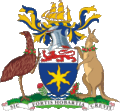European settlement
This district was originally known as Crayfish Point and the diaries of Robert Knopwood contain reference to expeditions to catch crayfish there.
The first European settlement at Taroona took place in the early 19th century, when land was granted to settlers who had relocated from Norfolk Island. For the remainder of that century, the area was largely used for farming, and was sparsely populated.
In the mid 1890s, Clarendon James Cox Lord purchased an 18-acre property which he called Taroona, after an Aboriginal word for sea shell. Lord built himself a pretty homestead and also established tea rooms where visitors could indulge in delicacies such as strawberries and cream while overlooking the River Derwent, Hobart. [7]
In the first half of the 20th century, more large and elegant residences were built, as well as beach shacks and cottages which were used for seaside holidays by the residents of Hobart. [6] Taroona Post Office opened on 2 August 1906. [8]
At the northern end of Taroona Beach, just above the foreshore, there is the grave of a young sailor and First Officer, Jas. Batchelor, who died on the schooner Venus in the Derwent Estuary in 1810, and was buried ashore on 28 January 1810. It is the oldest known European grave in Tasmania, and was declared an historic site by the Australian Heritage Commission on 21 March 1978. [9]
After World War II, significant subdivision of Taroona was undertaken, and the suburb's population rapidly expanded. Having been developed mainly in the "era of the automobile", Taroona was, from the beginning, a commuter suburb, and it has a notable absence of commercial or retail premises, with many of the early retail enterprises having lost the battle with larger supermarkets elsewhere. [6]





